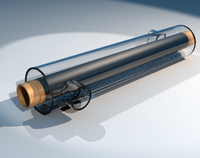
Photo from wikipedia
Abstract The solid solution phases with general formula Ni2Zn11-4δXδ (0≤ δ ≤~0.13) (X = In, Ga) have been synthesized by high-temperature solid-state synthesis. Their structures have been characterized by X-ray diffraction and… Click to show full abstract
Abstract The solid solution phases with general formula Ni2Zn11-4δXδ (0≤ δ ≤~0.13) (X = In, Ga) have been synthesized by high-temperature solid-state synthesis. Their structures have been characterized by X-ray diffraction and elemental analysis. The phases crystallize in the cubic space group I¯43m and adopt cubic γ-brass-type Ni2Zn11 structure, which is made of 26 atom γ-cluster. The unit cell of the Ni2Zn11-4δXδ contains 50–52 atoms depending upon the composition of the compounds. The pseudo-binary phases in Ni–Zn-X (X = In, Ga) are formed by the insertion of In or Ga in the structure of Ni2Zn11 by an exchange mechanism. Instead of direct substitution of Zn, In/Ga occupy at the empty centre of γ-cluster, probably, due to the large size difference in the atomic radii of Zn and In metals. The insertion of trivalent In or Ga is accompanied by the sharp depletion of bivalent Zn atoms from the γ-cluster to keep the valence electron concentration constant throughout the entire range of solid solution.
Journal Title: Journal of Solid State Chemistry
Year Published: 2020
Link to full text (if available)
Share on Social Media: Sign Up to like & get
recommendations!